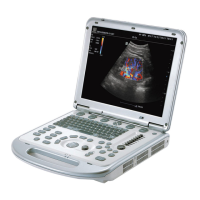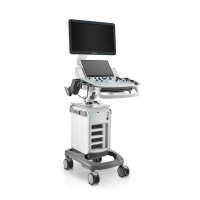8 Elastography
Operator’s Manual 8 - 3
hardness is displayed in quantitative manners. STE imaging provides you real elasto modulus for
quantification analysis.
STE imaging is not supported when the system is powered by battery.
8.2.1 Basic Procedures for STE Imaging
1. Select a proper probe. Perform 2D scan to locate the region.
2. Tap [STE] on the touch screen. Or press the user-defined <STE> key to enter the STE mode.
3. Adjust the ROI based on the lesion size, and press <Set> to adjust the ROI size and the
position. To compare the hardness between the lesion and the normal tissue, the ROI should
include the lesion and the normal tissue.
4. Keep the probe still to imaging, and adjust the parameter to obtain premium image.
5. Freeze the image, and replay the image if necessary.
6. Perform the measurement or add comment/body mark to the image if necessary.
7. Save the single-frame and multi-frame image.
8. Acquire high-quality image if necessary.
9. Press <B> on the control panel or tap [STE] on the touch screen to exit the shear wave
elastography mode, and return to B mode.
8.2.2 Image Parameters
E Quality
Used to select the transmitting frequency of the current probe, the real-time value of which is
displayed in the image parameter area in the upper left side of the screen.
Please select the frequency according to the detection depth and current tissue features.
Elas Metric
Used to adjust the elastography metric.
The metric includes Young’s modulus E (unit: kPa), shear modulus G (unit: kPa), and shear wave
velocity Cs (unit: m/s).

